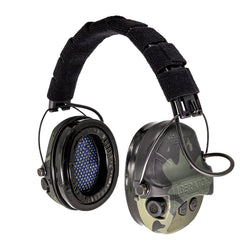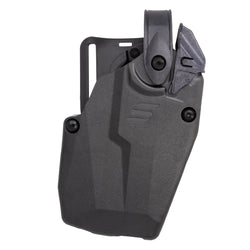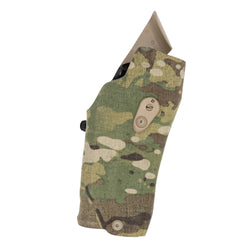In today’s fast-moving gun world, new accessories for handguns seem to come out quicker than the holsters. Slightly different slide contours or unique optics layouts can make it difficult to find a leather holster that fits perfectly.
As I’ve acquired new firearms, I’ve run into situations where I could not find a holster to fit my gun exactly. Some are too tight, too loose, don’t match the contour of the gun, or lack the sight cuts needed. This has become commonplace in the revolver world with all the Smith and Wesson Performance Center models, custom single actions, and the more exotic import revolvers.
But this isn’t limited to just revolvers; custom shop models of various autos are out there in abundance that “almost” fit your favorite holster.
The problem
Being a revolver hunter, I have found myself in this boat many times. Holster manufacturers can not possibly make a product that fits all of our different optics layouts on a wheelgun. Custom holster makers can make a one-off product for you, but this will take time. Frankly, sometimes we want to get out into the field right away with our new hunting setup.
For a couple of decades, I have had to lightly modify the fit of my holsters with a few simple steps. For hunting, I prefer a leather holster. It is quiet to draw, comfortable to either sit in a stand or stalk all day, and I can easily customize it. Leather holsters allow us to adjust their fit and modestly customize them with minimal tooling.
revolvers, optics, and leather Holsters
Revolvers can have optics over the top strap or barrel, and there is no one-size-fits-all holster that works well with them.
In the beginning, we were using large magnified pistol scopes and very large red dots. These forced you to nearly remove the whole front of a holster for clearance. But in the more recent years, with quality reflex optics coming onto the market, making modifications has become easier.

For this coming hunting season, I have a new revolver I am evaluating —a Spohr 44 Magnum that will be wearing an Ultradot Prime XT reflex sight mounted over the top strap. The Spohr, like many customs and Performance Center revolvers, utilizes LPA sights, which are taller than most sights on the market.
I need a few different holsters to accommodate the firearm in various situations. I chose the Bianchi Thumb Snap Holster and the Cyclone, as I have used various models of both holsters for a couple of decades with various firearms.

The Spohr will go into a standard S&W N frame holster as is, with the reflex sight removed, but the front sight will drag on the draw. To accommodate the reflex and the sights, I need to make a couple of modifications.
modifying the Leather holster
First up is to allow clearance for the reflex sight. Leather holsters are generally made with two layers of leather. Those two layers are both stitched and glued together, so we don’t need to worry too much about them delaminating.

To make the reflex sight cut, the first step is to ensure the gun is unloaded, and then slide the gun into the holster as far as possible with the sight mounted. Then, scribe a line for the width of the sight as well as the extra depth the gun needs to be inserted. A metal punch will scribe a decent line to follow.
the cut
Next, I use a razor knife (hobby knife) with a new blade and follow the lines. A new razor blade will slide through the thickest holster with ease. I take my time cutting with just modest pressure, as I will be unable to put the leather back should I make a mistake.

After making the cut and test-fitting the gun and optic in the holster, I use sandpaper to smooth the edges ever so slightly.

Now that the dangerous part is done with the sharp tools, we get to move on to simpler and safer tasks.
Leather is pliable when wet, which allows the holster to be shaped and stretched for sight clearance. This would also work for a custom semi-auto with a unique slide contour.
wet forming
Wet forming requires a few items.
- A dowel rod made of either plastic or wood that will not scratch the barrel. In this case, the dowel rod needs to be slightly taller than the front sight. This dowel will be used to stretch the leather for sight clearance.
- A bucket
- Plastic bag
- Warm water source
This next part is pretty simple. I place the revolver in the plastic bag to protect it from moisture for the next step.

After filling the bucket with warm water, I place the holster in it fully submerged for about 20 seconds.

Upon removing the holster from the water, I shake off the excess water and immediately insert the plastic-bag-covered gun with the dowel rod in position.
It is key that the dowel rod runs the full length of the holster so that it stretches the entire top to allow for front sight clearance.

At this point, the hard work is done; we just have to be patient. The holster should be left with the gun inside overnight to dry.

Final fit
The next day, upon removing the gun, bag, and dowel from the holster, I had a perfectly molded holster ready to go. This allowed me to take an off-the-shelf Bianchi holster and adjust it to suit my needs.

I have used Bianchi for decades since the start of my handgun hunting career and have never been let down by their product. With a few minor modifications, the leather allows me to utilize all of the modern optics and accessories found on the market.
I look forward to getting this holster into the field in Wyoming next month.









